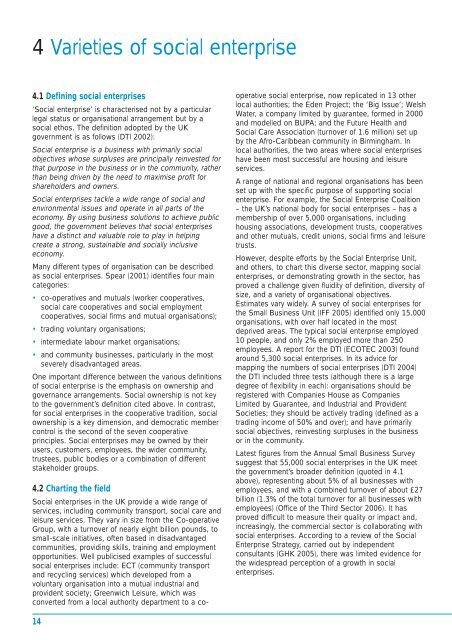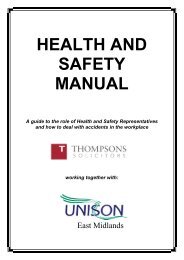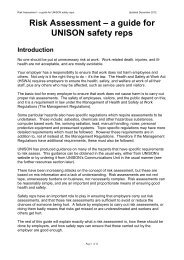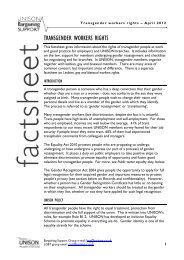Social Enterprises and the NHS - Unison
Social Enterprises and the NHS - Unison
Social Enterprises and the NHS - Unison
Create successful ePaper yourself
Turn your PDF publications into a flip-book with our unique Google optimized e-Paper software.
4 Varieties of social enterprise<br />
4.1 Defining social enterprises<br />
‘<strong>Social</strong> enterprise’ is characterised not by a particular<br />
legal status or organisational arrangement but by a<br />
social ethos. The definition adopted by <strong>the</strong> UK<br />
government is as follows (DTI 2002):<br />
<strong>Social</strong> enterprise is a business with primarily social<br />
objectives whose surpluses are principally reinvested for<br />
that purpose in <strong>the</strong> business or in <strong>the</strong> community, ra<strong>the</strong>r<br />
than being driven by <strong>the</strong> need to maximise profit for<br />
shareholders <strong>and</strong> owners.<br />
<strong>Social</strong> enterprises tackle a wide range of social <strong>and</strong><br />
environmental issues <strong>and</strong> operate in all parts of <strong>the</strong><br />
economy. By using business solutions to achieve public<br />
good, <strong>the</strong> government believes that social enterprises<br />
have a distinct <strong>and</strong> valuable role to play in helping<br />
create a strong, sustainable <strong>and</strong> socially inclusive<br />
economy.<br />
Many different types of organisation can be described<br />
as social enterprises. Spear (2001) identifies four main<br />
categories:<br />
• co-operatives <strong>and</strong> mutuals (worker cooperatives,<br />
social care cooperatives <strong>and</strong> social employment<br />
cooperatives, social firms <strong>and</strong> mutual organisations);<br />
• trading voluntary organisations;<br />
• intermediate labour market organisations;<br />
• <strong>and</strong> community businesses, particularly in <strong>the</strong> most<br />
severely disadvantaged areas.<br />
One important difference between <strong>the</strong> various definitions<br />
of social enterprise is <strong>the</strong> emphasis on ownership <strong>and</strong><br />
governance arrangements. <strong>Social</strong> ownership is not key<br />
to <strong>the</strong> government’s definition cited above. In contrast,<br />
for social enterprises in <strong>the</strong> cooperative tradition, social<br />
ownership is a key dimension, <strong>and</strong> democratic member<br />
control is <strong>the</strong> second of <strong>the</strong> seven cooperative<br />
principles. <strong>Social</strong> enterprises may be owned by <strong>the</strong>ir<br />
users, customers, employees, <strong>the</strong> wider community,<br />
trustees, public bodies or a combination of different<br />
stakeholder groups.<br />
4.2 Charting <strong>the</strong> field<br />
<strong>Social</strong> enterprises in <strong>the</strong> UK provide a wide range of<br />
services, including community transport, social care <strong>and</strong><br />
leisure services. They vary in size from <strong>the</strong> Co-operative<br />
Group, with a turnover of nearly eight billion pounds, to<br />
small-scale initiatives, often based in disadvantaged<br />
communities, providing skills, training <strong>and</strong> employment<br />
opportunities. Well publicised examples of successful<br />
social enterprises include: ECT (community transport<br />
<strong>and</strong> recycling services) which developed from a<br />
voluntary organisation into a mutual industrial <strong>and</strong><br />
provident society; Greenwich Leisure, which was<br />
converted from a local authority department to a co-<br />
14<br />
operative social enterprise, now replicated in 13 o<strong>the</strong>r<br />
local authorities; <strong>the</strong> Eden Project; <strong>the</strong> ‘Big Issue’; Welsh<br />
Water, a company limited by guarantee, formed in 2000<br />
<strong>and</strong> modelled on BUPA; <strong>and</strong> <strong>the</strong> Future Health <strong>and</strong><br />
<strong>Social</strong> Care Association (turnover of 1.6 million) set up<br />
by <strong>the</strong> Afro-Caribbean community in Birmingham. In<br />
local authorities, <strong>the</strong> two areas where social enterprises<br />
have been most successful are housing <strong>and</strong> leisure<br />
services.<br />
A range of national <strong>and</strong> regional organisations has been<br />
set up with <strong>the</strong> specific purpose of supporting social<br />
enterprise. For example, <strong>the</strong> <strong>Social</strong> Enterprise Coalition<br />
– <strong>the</strong> UK’s national body for social enterprises – has a<br />
membership of over 5,000 organisations, including<br />
housing associations, development trusts, cooperatives<br />
<strong>and</strong> o<strong>the</strong>r mutuals, credit unions, social firms <strong>and</strong> leisure<br />
trusts.<br />
However, despite efforts by <strong>the</strong> <strong>Social</strong> Enterprise Unit,<br />
<strong>and</strong> o<strong>the</strong>rs, to chart this diverse sector, mapping social<br />
enterprises, or demonstrating growth in <strong>the</strong> sector, has<br />
proved a challenge given fluidity of definition, diversity of<br />
size, <strong>and</strong> a variety of organisational objectives.<br />
Estimates vary widely. A survey of social enterprises for<br />
<strong>the</strong> Small Business Unit (IFF 2005) identified only 15,000<br />
organisations, with over half located in <strong>the</strong> most<br />
deprived areas. The typical social enterprise employed<br />
10 people, <strong>and</strong> only 2% employed more than 250<br />
employees. A report for <strong>the</strong> DTI (ECOTEC 2003) found<br />
around 5,300 social enterprises. In its advice for<br />
mapping <strong>the</strong> numbers of social enterprises (DTI 2004)<br />
<strong>the</strong> DTI included three tests (although <strong>the</strong>re is a large<br />
degree of flexibility in each): organisations should be<br />
registered with Companies House as Companies<br />
Limited by Guarantee, <strong>and</strong> Industrial <strong>and</strong> Provident<br />
Societies; <strong>the</strong>y should be actively trading (defined as a<br />
trading income of 50% <strong>and</strong> over); <strong>and</strong> have primarily<br />
social objectives, reinvesting surpluses in <strong>the</strong> business<br />
or in <strong>the</strong> community.<br />
Latest figures from <strong>the</strong> Annual Small Business Survey<br />
suggest that 55,000 social enterprises in <strong>the</strong> UK meet<br />
<strong>the</strong> government’s broader definition (quoted in 4.1<br />
above), representing about 5% of all businesses with<br />
employees, <strong>and</strong> with a combined turnover of about £27<br />
billion (1.3% of <strong>the</strong> total turnover for all businesses with<br />
employees) (Office of <strong>the</strong> Third Sector 2006). It has<br />
proved difficult to measure <strong>the</strong>ir quality or impact <strong>and</strong>,<br />
increasingly, <strong>the</strong> commercial sector is collaborating with<br />
social enterprises. According to a review of <strong>the</strong> <strong>Social</strong><br />
Enterprise Strategy, carried out by independent<br />
consultants (GHK 2005), <strong>the</strong>re was limited evidence for<br />
<strong>the</strong> widespread perception of a growth in social<br />
enterprises.















